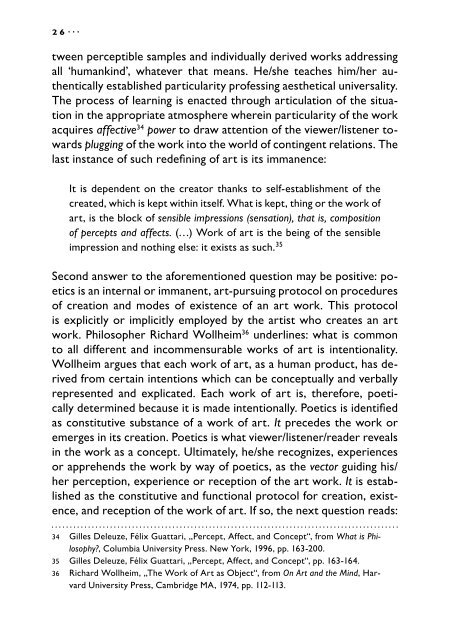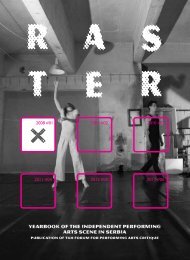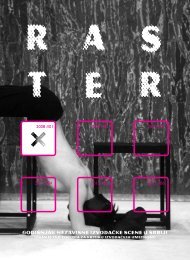Miško Šuvaković Epistemology of Art - TkH
Miško Šuvaković Epistemology of Art - TkH
Miško Šuvaković Epistemology of Art - TkH
Create successful ePaper yourself
Turn your PDF publications into a flip-book with our unique Google optimized e-Paper software.
26··· ··· 27<br />
tween perceptible samples and individually derived works addressing<br />
all ‘humankind’, whatever that means. He/she teaches him/her authentically<br />
established particularity pr<strong>of</strong>essing aesthetical universality.<br />
The process <strong>of</strong> learning is enacted through articulation <strong>of</strong> the situation<br />
in the appropriate atmosphere wherein particularity <strong>of</strong> the work<br />
acquires affective 34 power to draw attention <strong>of</strong> the viewer/listener towards<br />
plugging <strong>of</strong> the work into the world <strong>of</strong> contingent relations. The<br />
last instance <strong>of</strong> such redefining <strong>of</strong> art is its immanence:<br />
It is dependent on the creator thanks to self-establishment <strong>of</strong> the<br />
created, which is kept within itself. What is kept, thing or the work <strong>of</strong><br />
art, is the block <strong>of</strong> sensible impressions (sensation), that is, composition<br />
<strong>of</strong> percepts and affects. (…) Work <strong>of</strong> art is the being <strong>of</strong> the sensible<br />
impression and nothing else: it exists as such. 35<br />
Second answer to the aforementioned question may be positive: poetics<br />
is an internal or immanent, art-pursuing protocol on procedures<br />
<strong>of</strong> creation and modes <strong>of</strong> existence <strong>of</strong> an art work. This protocol<br />
is explicitly or implicitly employed by the artist who creates an art<br />
work. Philosopher Richard Wollheim 36 underlines: what is common<br />
to all different and incommensurable works <strong>of</strong> art is intentionality.<br />
Wollheim argues that each work <strong>of</strong> art, as a human product, has derived<br />
from certain intentions which can be conceptually and verbally<br />
represented and explicated. Each work <strong>of</strong> art is, therefore, poetically<br />
determined because it is made intentionally. Poetics is identified<br />
as constitutive substance <strong>of</strong> a work <strong>of</strong> art. It precedes the work or<br />
emerges in its creation. Poetics is what viewer/listener/reader reveals<br />
in the work as a concept. Ultimately, he/she recognizes, experiences<br />
or apprehends the work by way <strong>of</strong> poetics, as the vector guiding his/<br />
her perception, experience or reception <strong>of</strong> the art work. It is established<br />
as the constitutive and functional protocol for creation, existence,<br />
and reception <strong>of</strong> the work <strong>of</strong> art. If so, the next question reads:<br />
34 Gilles Deleuze, Félix Guattari, „Percept, Affect, and Concept“, from What is Philosophy?,<br />
Columbia University Press. New York, 1996, pp. 163-200.<br />
35 Gilles Deleuze, Félix Guattari, „Percept, Affect, and Concept“, pp. 163-164.<br />
36 Richard Wollheim, „The Work <strong>of</strong> <strong>Art</strong> as Object“, from On <strong>Art</strong> and the Mind, Harvard<br />
University Press, Cambridge MA, 1974, pp. 112-113.<br />
what is this constitutive relationship between the work <strong>of</strong> art and<br />
its particular poetics? Namely, how does poetics exist in the work<br />
<strong>of</strong> art? This also raises a question <strong>of</strong> relations between ‘perceptible’<br />
and ‘conceptual’ in the work <strong>of</strong> art. The work <strong>of</strong> art is not presumed<br />
to be or posited as an autonomous object (thing, situation, event), isolated<br />
from specific geographical and historical culture where it was<br />
created, displayed, and perceived, where it entered the process <strong>of</strong><br />
exchange, reception and consumption <strong>of</strong> art and culture. The work<br />
<strong>of</strong> art exists, and that is an ontological construction, just and only as<br />
part <strong>of</strong> social practices, and, more precisely, <strong>of</strong> autonomous artistic<br />
practices. This implies that a work <strong>of</strong> art is connected with relations<br />
between social and discursive practices wherein it emerges as perceivable.<br />
But being perceivable does not imply exclusion <strong>of</strong> discursive<br />
aspects either from the work or its environment – or its artistic, aesthetical,<br />
cultural or social figurations, functions and contingencies. To<br />
the contrary, it implies that discursive and perceptible create a kind<br />
<strong>of</strong> a phenomenal-discursive plan for origination and existence <strong>of</strong> the<br />
work <strong>of</strong> art in a particular geographically or historically determined<br />
society. Therefore is the work <strong>of</strong> art not only what emerges before<br />
our senses – it is also knowledge <strong>of</strong> art history, culture theory, social<br />
customs, habits or modes <strong>of</strong> identification. 37 <strong>Art</strong>hur C. Danto, in his<br />
essay „The Appreciation and Interpretation <strong>of</strong> Works <strong>of</strong> <strong>Art</strong>“ 38 , elaborated<br />
a protocol <strong>of</strong> relations between the art work and direct and<br />
indirect interpretations surrounding and situating it 39 in the <strong>Art</strong>world.<br />
His initial statement reads:<br />
My view, philosophically, is that interpretations constitute works <strong>of</strong><br />
art, so that you do not, as it were, have the artwork on one side and<br />
the interpretation on the other. 40<br />
37 <strong>Art</strong>hur C. Danto, „The <strong>Art</strong>world“ (1964), from Joseph Margolis (ed), Philosophy<br />
Looks at the <strong>Art</strong>s – Contemporary Readings in Aesthetics (3. edition), Temple University<br />
Press, Philadelphia, 1987, p. 162.<br />
38 <strong>Art</strong>hur C. Danto, „The Appreciation and Interpretation <strong>of</strong> Works <strong>of</strong> <strong>Art</strong>“, from<br />
The Philosophical Disenfranchisement <strong>of</strong> <strong>Art</strong>, Columbia University Press, New York,<br />
1986, pp. 23-46.<br />
39 <strong>Art</strong>hur C. Danto, „The <strong>Art</strong>world“, p. 164.<br />
40 <strong>Art</strong>hur C. Danto, „The Appreciation and Interpretation <strong>of</strong> Works <strong>of</strong> <strong>Art</strong>“, p. 23.







